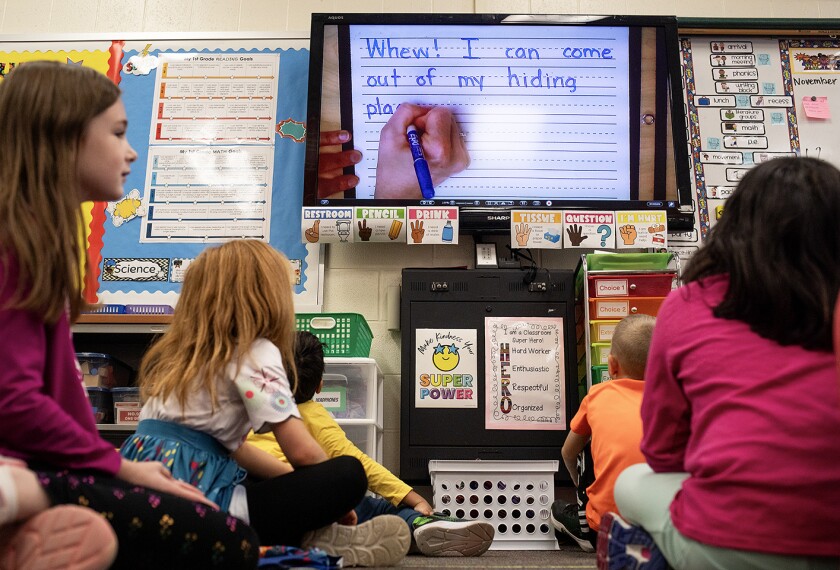What makes for a “good” curriculum? It’s a simple question with no easy answer. Depending on who’s providing the definition, a good curriculum could mean one that aligns with state standards, or one that’s easy to use, or one that has studies demonstrating its effectiveness at improving student outcomes.
In many states, leaders want districts to adopt “high-quality instructional materials,” and say that teachers should get “curriculum-based” training on how to use these programs.
But two new surveys focused on math teaching show that educators’ understanding of these two terms varies widely—and often doesn’t align with how researchers define them.
It’s a disconnect that can seem wonky and technical, but could have big implications for how students learn—and researchers’ ability to evaluate the effectiveness of different programs.
One study, from RAND, was released last month. The other, a Gallup poll sponsored by the Bill & Melinda Gates Foundation, was published Tuesday. (The Gates Foundation supports the nonprofit that publishes Education Week; the media organization retains sole editorial control over its articles.)
“When there isn’t a roughly common understanding of a term, it makes it really hard to measure in things like surveys, and even in interviews,” said Elizabeth Steiner, a senior policy researcher at RAND, and the lead author on one of the studies.
The RAND study surveyed a nationally representative group of teachers, principals, and district leaders about curriculum-aligned professional learning during the 2023-24 school year. They found that curriculum alignment was one of the top considerations for principals when selecting math professional learning—98 percent said they took it into account. And most teachers said that their math PD was based on their curriculum.
RAND researchers defined curriculum-based PD as training that “integrates or uses the curriculum materials that teachers use in their classroom every day.” But in interviews with about 100 teachers and principals, they described “curriculum-based” in different ways: Some said it meant providing guidance on how to use materials, but others said it meant teaching to state standards, while others simply said it meant following the program as written.
A different report from Gallup, sponsored by the Gates Foundation, found similar variation in school and district leaders’ understanding of “high-quality instructional materials.”
In a survey of nearly 1,500 principals and school district leaders, only 1 in 4 said their district had an official definition of the term. When asked what resources they considered to determine whether materials were high-quality, leaders cited a variety of sources—83 percent referenced state guidelines, 58 percent relied on teacher feedback, 55 percent used district guidelines, and 54 percent turned to independent curriculum reviewers like EdReports.
This variation suggests there’s room for more clarity and shared consensus in the field, said Steiner.
“There’s a real need to think with practitioners about what curriculum-aligned professional learning actually means,” she said.
Groups prioritize different metrics, from research backing to student engagement
The movement for districts to adopt high-quality curricula started in earnest over a decade ago, as districts searched for materials that would meet the requirements outlined in Common Core State Standards—a set of shared learning goals initially launched in 2009 and adopted by almost all the states.
In the years since, about half of states revised their standards or withdrew from the initiative, but the standards still set the agenda for the curriculum publishing landscape going forward. Curriculum reviewers—most notably, the nonprofit EdReports—emerged to evaluate programs against the standards, as well as for other features such as rigor and usability.
But exactly what constitutes high-quality materials is still murky. Even initiatives that aim to incentivize more districts to adopt them don’t always have a singular definition.
For example, the High Quality Instructional Materials and Professional Development Network, a project of the Council of Chief State School Officers, supports states that want to increase uptake of high-quality curricula. But its policy roadmap doesn’t provide a description of what these curricula entail; rather, it directs states to develop their own definitions and categorizations.
In some cases, debate over definitions has become contentious.
In evaluating early reading programs, for instance, many states use EdReports reviews as a marker of quality. But some programs that received high marks from EdReports have failed other reviews that examine materials for evidence of research-tested instructional approaches, leaving leaders with contradictory verdicts.
Data from the Gallup survey shows that research backing is paramount for school leaders.
Almost all principals and district leaders said that when choosing a math curriculum, evidence that it will “improve student outcomes” is somewhat or very important.
Other research shows that teachers, too, have their own definition of what constitutes quality materials, said Steiner.
A survey of about 1,750 middle and high school math and English/language arts teachers, published by RAND in 2021, found that it was important to teachers for materials to be appropriately challenging, interactive or collaborative, and connected to student interests.
“Those criteria aren’t often things that you hear talked about when policymakers talk about the quality of materials,” said Steiner. “They talk about the research base, they talk about evidence about how they improve student learning.”






